Ullensvang
Ullensvang is a municipality in Vestland county, Norway. It is located in the traditional district of Hardanger. The administrative centre is the town of Odda. Some of the notable villages in the municipality include Lofthus, Utne, Vikebygd, Alsåker, Botnen, Eitrheim, Håra, Røldal, Seljestad, Skare, Tyssedal, Jondal, Herand, Kysnesstranda, and Torsnes.
Ullensvang kommune | |
|---|---|
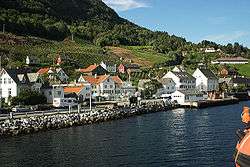 View of Utne in Ullensvang | |
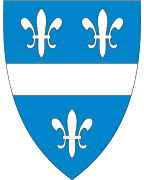 Coat of arms  Vestland within Norway | |
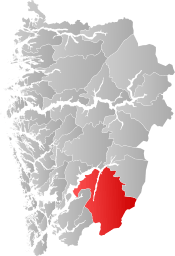 Ullensvang within Vestland | |
| Coordinates: 60°18′42″N 06°48′53″E | |
| Country | Norway |
| County | Vestland |
| District | Hardanger |
| Established | 1 Jan 1838 |
| Administrative centre | Odda |
| Government | |
| • Mayor (2019) | Roald Aga Haug (Ap) |
| Area | |
| • Total | 3,236.63 km2 (1,249.67 sq mi) |
| • Land | 2,970.20 km2 (1,146.80 sq mi) |
| • Water | 266.43 km2 (102.87 sq mi) 8.2% |
| Area rank | 12 in Norway |
| Population (2020) | |
| • Total | 11,048 |
| • Rank | 104 in Norway |
| • Density | 3.7/km2 (10/sq mi) |
| • Change (10 years) | -3.6% |
| Demonym(s) | Sørfjøre Sørfjording[1] |
| Time zone | UTC+01:00 (CET) |
| • Summer (DST) | UTC+02:00 (CEST) |
| ISO 3166 code | NO-4618 |
| Official language form | Nynorsk[2] |
| Website | ullensvang |
The main inhabited part of Ullensvang municipality lies just to the west of Hardangervidda National Park, which covers most of the Hardangervidda plateau, Europe's largest mountain plateau. Most inhabitants live in the narrow coastal mountainsides and valleys along the Hardangerfjorden and Sørfjorden. The largest urban areas in Ullensvang are Odda, Kinsarvik, Jondal, and Lofthus. The Norwegian National Road 13 and the European route E134 are the two main roads through the municipality. National road 13 crosses the Hardangerfjorden via the Hardanger Bridge in the far northern part of the municipality.
The 3,237-square-kilometre (1,250 sq mi) municipality is the 12th largest by area out of the 356 municipalities in Norway. Ullensvang is the 104th most populous municipality in Norway with a population of 11,048. The municipality's population density is 3.7 inhabitants per square kilometre (9.6/sq mi) and its population has decreased by 3.6% over the previous 10-year period.[3][4] The number of inhabitants has shown a decrease of several hundred people since 1980. This development can be seen in light of the general depopulation of rural Norway.
In 2016, the chief of police for Vestlandet formally suggested a reconfiguration of police districts and stations. He proposed that the police station for Ullensvang og Eidfjord be closed.[5]
General information
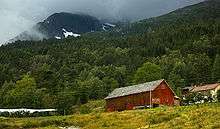
Name
The municipality (originally the parish) is named after the old Ullensvang farm (Old Norse: Ullinsvangr), since Ullensvang Church was built there. The first element is the genitive case of the name of the Norse god Ullin (sideform of Ullr). The last element is vangr which means "field" or "meadow".[6]
Prior to the 2020 municipal merger, this municipality was called Ullensvang herad, but after the merger it was called Ullensvang kommune.
Coat of arms
The coat of arms was granted on 8 November 1979. The arms are red with a horizontal gold stripe across the middle, with three gold fleur-de-lis designs (two above the stripe, one below). The municipal arms are derived from the arms of nobleman from the area, Sigurd Brynjulvsson Galte, and they can be seen on his gravestone dating back to 1302 at the local church. As it is the oldest gravestone in the church, the arms were well known in the village, hence the choice for the arms of this knight as municipal arms.[7]
On 1 January 2020, the arms were modified by changing the colors from red and gold to blue and white after a large municipal merger.
 Current arms since 2020
Current arms since 2020 Arms from 1979 to 2019
Arms from 1979 to 2019
Churches
The Church of Norway has eight parishes (sokn) within the municipality of Ullensvang. It is part of the Hardanger og Voss prosti (deanery) in the Diocese of Bjørgvin.
| Parish (sokn) | Church name | Location of the church | Year built |
|---|---|---|---|
| Jondal | Jondal Church | Jondal | 1888 |
| Kinsarvik | Kinsarvik Church | Kinsarvik | 1150 |
| Odda | Odda Church | Odda | 1870 |
| Røldal | Røldal Stave Church | Røldal | c. 1250 |
| Skare | Skare Church | Skare | 1926 |
| Tyssedal | Tyssedal Church | Tyssedal | 1965 |
| Ullensvang | Ullensvang Church | Lofthus | 1250 |
| Utne | Utne Church | Utne | 1895 |
History

| Historical population | ||
|---|---|---|
| Year | Pop. | ±% |
| 1951 | 2,294 | — |
| 1960 | 2,420 | +5.5% |
| 1970 | 4,848 | +100.3% |
| 1980 | 4,041 | −16.6% |
| 1990 | 3,988 | −1.3% |
| 2000 | 3,562 | −10.7% |
| 2010 | 3,382 | −5.1% |
| 2020 | 11,152 | +229.7% |
| Source: Statistics Norway. Note: there were major border changes to the municipality in 1964 and 1977 causing large changes in the population. | ||
On 1 January 1838, the large parish of Kinsarvik was established as a municipality (see formannskapsdistrikt law). The large parish was made up of the main parish and the annex of Ullensvang. On 1 January 1869, Ullensvang became the main parish and Kinsarvik became an annex to Ullensvang. At this time the municipality changed its name to Ullensvang. On 1 January 1882, a small area of Ullensvang (population: 22) was transferred to the neighboring municipality of Vikør. On 1 July 1913, the municipality of Ullensvang was divided into three parts: the northwestern part became Kinsarvik Municipality, the southern part became Odda Municipality, and the rest remained as Ullensvang Municipality, albeit much smaller. This left Ullensvang with 1,941 residents.
During the 1960s, there were many municipal mergers across Norway due to the work of the Schei Committee. On 1 January 1964, the following areas were merged into one large municipality: all of Ullensvang Municipality, all of Eidfjord Municipality, and most of Kinsarvik Municipality (except for the Lussand-Kvanndal area which went to Granvin Municipality). The newly enlarged municipality was named Ullensvang. On 1 January 1965, the Åsgrenda area of Kvam Municipality (population: 61) was transferred to Ullensvang. This new, large municipality of Ullensvang that was created in 1964-1965 was not long-lived. On 1 January 1977, the area that once was Eidfjord Municipality became its own municipality once again. This left Ullensvang with 3,937 residents.[8]
On 1 January 2020, the three neighboring municipalities of Jondal, Odda, and Ullensvang were merged into a new, larger Ullensvang Municipality. At that time, the administrative centre was moved from the village of Kinsarvik to the larger town of Odda.[9]
Geography
The municipality of Ullensvang is located on the shores of the Hardangerfjorden and the Sørfjorden and it stretches all the way up to the Folgefonna glacier inside Folgefonna National Park on the Folgefonna peninsula in the western part of the municipality. It continues up to the vast Hardangervidda plateau in the east, including part of the Hardangervidda National Park. The lakes Kvensjøen and Veivatnet as well as the mountain Hårteigen are all located in Ullensvang on the plateau.[10]
Government
All municipalities in Norway, including Ullensvang, are responsible for primary education (through 10th grade), outpatient health services, senior citizen services, unemployment and other social services, zoning, economic development, and municipal roads. The municipality is governed by a municipal council of elected representatives, which in turn elects a mayor.[11] The municipality falls under the Hardanger District Court and the Gulating Court of Appeal.
Municipal council
The municipal council (Kommunestyre) of Ullensvang is made up of 33 representatives that are elected to four year terms. The party breakdown of the council is as follows:
| Party Name (in Nynorsk) | Number of representatives | |
|---|---|---|
| Labour Party (Arbeidarpartiet) | 14 | |
| Progress Party (Framstegspartiet) | 1 | |
| Conservative Party (Høgre) | 4 | |
| Christian Democratic Party (Kristeleg Folkeparti) | 1 | |
| Red Party (Raudt) | 2 | |
| Centre Party (Senterpartiet) | 9 | |
| Socialist Left Party (Sosialistisk Venstreparti) | 1 | |
| Liberal Party (Venstre) | 1 | |
| Total number of members: | 33 | |
| Party Name (in Nynorsk) | Number of representatives | |
|---|---|---|
| Labour Party (Arbeidarpartiet) | 3 | |
| Conservative Party (Høgre) | 3 | |
| Christian Democratic Party (Kristeleg Folkeparti) | 1 | |
| Centre Party (Senterpartiet) | 9 | |
| Socialist Left Party (Sosialistisk Venstreparti) | 3 | |
| Liberal Party (Venstre) | 2 | |
| Total number of members: | 21 | |
| Party Name (in Nynorsk) | Number of representatives | |
|---|---|---|
| Labour Party (Arbeidarpartiet) | 2 | |
| Conservative Party (Høgre) | 4 | |
| Christian Democratic Party (Kristeleg Folkeparti) | 1 | |
| Centre Party (Senterpartiet) | 8 | |
| Socialist Left Party (Sosialistisk Venstreparti) | 1 | |
| Liberal Party (Venstre) | 5 | |
| Total number of members: | 21 | |
| Party Name (in Nynorsk) | Number of representatives | |
|---|---|---|
| Labour Party (Arbeidarpartiet) | 3 | |
| Conservative Party (Høgre) | 4 | |
| Christian Democratic Party (Kristeleg Folkeparti) | 1 | |
| Centre Party (Senterpartiet) | 9 | |
| Socialist Left Party (Sosialistisk Venstreparti) | 2 | |
| Liberal Party (Venstre) | 2 | |
| Total number of members: | 21 | |
| Party Name (in Nynorsk) | Number of representatives | |
|---|---|---|
| Labour Party (Arbeidarpartiet) | 3 | |
| Conservative Party (Høgre) | 6 | |
| Christian Democratic Party (Kristeleg Folkeparti) | 1 | |
| Centre Party (Senterpartiet) | 7 | |
| Socialist Left Party (Sosialistisk Venstreparti) | 3 | |
| Liberal Party (Venstre) | 1 | |
| Total number of members: | 21 | |
| Party Name (in Nynorsk) | Number of representatives | |
|---|---|---|
| Labour Party (Arbeidarpartiet) | 3 | |
| Conservative Party (Høgre) | 7 | |
| Christian Democratic Party (Kristeleg Folkeparti) | 1 | |
| Centre Party (Senterpartiet) | 6 | |
| Socialist Left Party (Sosialistisk Venstreparti) | 2 | |
| Liberal Party (Venstre) | 2 | |
| Total number of members: | 21 | |
| Party Name (in Nynorsk) | Number of representatives | |
|---|---|---|
| Labour Party (Arbeidarpartiet) | 6 | |
| Conservative Party (Høgre) | 4 | |
| Christian Democratic Party (Kristeleg Folkeparti) | 1 | |
| Centre Party (Senterpartiet) | 10 | |
| Socialist Left Party (Sosialistisk Venstreparti) | 2 | |
| Liberal Party (Venstre) | 2 | |
| Total number of members: | 25 | |
| Party Name (in Nynorsk) | Number of representatives | |
|---|---|---|
| Labour Party (Arbeidarpartiet) | 4 | |
| Conservative Party (Høgre) | 6 | |
| Christian Democratic Party (Kristeleg Folkeparti) | 1 | |
| Centre Party (Senterpartiet) | 9 | |
| Socialist Left Party (Sosialistisk Venstreparti) | 3 | |
| Liberal Party (Venstre) | 2 | |
| Total number of members: | 25 | |
| Party Name (in Nynorsk) | Number of representatives | |
|---|---|---|
| Labour Party (Arbeidarpartiet) | 6 | |
| Conservative Party (Høgre) | 5 | |
| Christian Democratic Party (Kristeleg Folkeparti) | 1 | |
| Centre Party (Senterpartiet) | 8 | |
| Socialist Left Party (Sosialistisk Venstreparti) | 2 | |
| Liberal Party (Venstre) | 2 | |
| Non-party list (Upolitisk liste) | 1 | |
| Total number of members: | 25 | |
| Party Name (in Nynorsk) | Number of representatives | |
|---|---|---|
| Labour Party (Arbeidarpartiet) | 5 | |
| Progress Party (Framstegspartiet) | 1 | |
| Conservative Party (Høgre) | 5 | |
| Christian Democratic Party (Kristeleg Folkeparti) | 2 | |
| Centre Party (Senterpartiet) | 9 | |
| Socialist Left Party (Sosialistisk Venstreparti) | 1 | |
| Liberal Party (Venstre) | 2 | |
| Total number of members: | 25 | |
| Party Name (in Nynorsk) | Number of representatives | |
|---|---|---|
| Labour Party (Arbeidarpartiet) | 6 | |
| Conservative Party (Høgre) | 7 | |
| Christian Democratic Party (Kristeleg Folkeparti) | 2 | |
| Centre Party (Senterpartiet) | 8 | |
| Liberal Party (Venstre) | 2 | |
| Total number of members: | 25 | |
| Party Name (in Nynorsk) | Number of representatives | |
|---|---|---|
| Labour Party (Arbeidarpartiet) | 9 | |
| Conservative Party (Høgre) | 4 | |
| Christian Democratic Party (Kristeleg Folkeparti) | 2 | |
| Centre Party (Senterpartiet) | 11 | |
| Liberal Party (Venstre) | 2 | |
| Local list (Bygdelista) | 1 | |
| Total number of members: | 29 | |
| Party Name (in Nynorsk) | Number of representatives | |
|---|---|---|
| Labour Party (Arbeidarpartiet) | 8 | |
| Centre Party (Senterpartiet) | 10 | |
| Joint List(s) of Non-Socialist Parties (Borgarlege Felleslister) | 9 | |
| Local List(s) (Lokale lister) | 2 | |
| Total number of members: | 29 | |
| Party Name (in Nynorsk) | Number of representatives | |
|---|---|---|
| Labour Party (Arbeidarpartiet) | 8 | |
| Conservative Party (Høgre) | 4 | |
| Christian Democratic Party (Kristeleg Folkeparti) | 2 | |
| Centre Party (Senterpartiet) | 10 | |
| Liberal Party (Venstre) | 5 | |
| Total number of members: | 29 | |
| Party Name (in Nynorsk) | Number of representatives | |
|---|---|---|
| Labour Party (Arbeidarpartiet) | 8 | |
| Conservative Party (Høgre) | 4 | |
| Christian Democratic Party (Kristeleg Folkeparti) | 1 | |
| Centre Party (Senterpartiet) | 10 | |
| Liberal Party (Venstre) | 6 | |
| Total number of members: | 29 | |
| Party Name (in Nynorsk) | Number of representatives | |
|---|---|---|
| Labour Party (Arbeidarpartiet) | 3 | |
| Conservative Party (Høgre) | 1 | |
| Centre Party (Senterpartiet) | 5 | |
| Liberal Party (Venstre) | 4 | |
| Total number of members: | 13 | |
| Party Name (in Nynorsk) | Number of representatives | |
|---|---|---|
| Labour Party (Arbeidarpartiet) | 4 | |
| Local List(s) (Lokale lister) | 9 | |
| Total number of members: | 13 | |
| Party Name (in Nynorsk) | Number of representatives | |
|---|---|---|
| Labour Party (Arbeidarpartiet) | 3 | |
| Liberal Party (Venstre) | 6 | |
| Joint List(s) of Non-Socialist Parties (Borgarlege Felleslister) | 3 | |
| Total number of members: | 12 | |
| Party Name (in Nynorsk) | Number of representatives | |
|---|---|---|
| Labour Party (Arbeidarpartiet) | 3 | |
| Joint List(s) of Non-Socialist Parties (Borgarlege Felleslister) | 9 | |
| Total number of members: | 12 | |
| Party Name (in Nynorsk) | Number of representatives | |
|---|---|---|
| Labour Party (Arbeidarpartiet) | 5 | |
| Local List(s) (Lokale lister) | 7 | |
| Total number of members: | 12 | |
| Party Name (in Nynorsk) | Number of representatives | |
|---|---|---|
| Labour Party (Arbeidarpartiet) | 2 | |
| Joint List(s) of Non-Socialist Parties (Borgarlege Felleslister) | 10 | |
| Total number of members: | 12 | |
Attractions
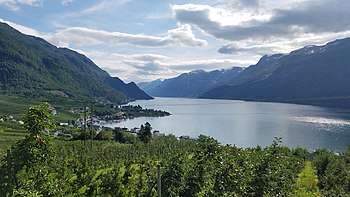
Ullensvang is Norway's biggest supplier of fruit, especially sweet cherries and apples. Every summer a cherry festival is held at Lofthus, where the Norwegian championship of cherry stone spitting is held. The record is 14.24 metres (46.7 ft) by S. Kleivkaas. Each May, a musical festival is held at Ullensvang Hotel (built in 1846), when musicians from all of Norway come to the village. The famous composer Edvard Grieg spent many summers at Lofthus, and the festival is held in his honor. During the summer, the population is doubled due to tourism. Attractions in addition to the previous mentioned, are the medieval Ullensvang Church at Lofthus (built around 1250) and Kinsarvik Church (built around 1150), several waterfalls such as the Skrikjofossen, the flowering season in May, and museums at Aga, Utne, and Skredhaugen.
References
- "Navn på steder og personer: Innbyggjarnamn" (in Norwegian). Språkrådet.
- "Forskrift om målvedtak i kommunar og fylkeskommunar" (in Norwegian). Lovdata.no.
- Statistisk sentralbyrå (2020). "Table: 06913: Population 1 January and population changes during the calendar year (M)" (in Norwegian).
- Statistisk sentralbyrå (2020). "09280: Area of land and fresh water (km²) (M)" (in Norwegian).
- Fjelltveit, Ingvild; Raunholm, Per Vidar (2016-12-20). "Foreslår å legge ned 17 lensmannskontor i Vest politidistrikt". NRK Hordaland (in Norwegian). Retrieved 2017-10-20.
- Rygh, Oluf (1919). Norske gaardnavne: Nordre Bergenhus amt (in Norwegian) (12 ed.). Kristiania, Norge: W. C. Fabritius & sønners bogtrikkeri. p. 449.
- "Civic heraldry of Norway - Norske Kommunevåpen". Heraldry of the World. Retrieved 2020-02-02.
- Jukvam, Dag (1999). "Historisk oversikt over endringer i kommune- og fylkesinndelingen" (PDF) (in Norwegian). Statistisk sentralbyrå.
- "Ullensvang kommune - den nye kommune i Hardanger" (in Norwegian). Retrieved 2017-10-24.
- Store norske leksikon. "Ullensvang" (in Norwegian). Retrieved 2014-06-05.
- Hansen, Tore, ed. (2016-05-12). "kommunestyre". Store norske leksikon (in Norwegian). Kunnskapsforlaget. Retrieved 2020-02-02.
- "Tall for Norge: Kommunestyrevalg 2019 - Vestland". Valg Direktoratet. Retrieved 2020-02-02.
- "Table: 04813: Members of the local councils, by party/electoral list at the Municipal Council election (M)" (in Norwegian). Statistics Norway.
- "Tall for Norge: Kommunestyrevalg 2011 - Hordaland". Valg Direktoratet. Retrieved 2020-02-02.
- "Kommunestyrevalget 1995" (PDF) (in Norwegian). Oslo-Kongsvinger: Statistisk sentralbyrå. 1996. Retrieved 2020-02-20.
- "Kommunestyrevalget 1991" (PDF) (in Norwegian). Oslo-Kongsvinger: Statistisk sentralbyrå. 1993. Retrieved 2020-02-20.
- "Kommunestyrevalget 1987" (PDF) (in Norwegian). Oslo-Kongsvinger: Statistisk sentralbyrå. 1988. Retrieved 2020-02-20.
- "Kommunestyrevalget 1983" (PDF) (in Norwegian). Oslo-Kongsvinger: Statistisk sentralbyrå. 1984. Retrieved 2020-02-20.
- "Kommunestyrevalget 1979" (PDF) (in Norwegian). Oslo: Statistisk sentralbyrå. 1979. Retrieved 2020-02-20.
- "Kommunevalgene 1975" (PDF) (in Norwegian). Oslo: Statistisk sentralbyrå. 1977. Retrieved 2020-05-10.
- "Kommunevalgene 1972" (PDF) (in Norwegian). Oslo: Statistisk sentralbyrå. 1973. Retrieved 2020-05-10.
- "Kommunevalgene 1967" (PDF) (in Norwegian). Oslo: Statistisk sentralbyrå. 1967. Retrieved 2020-05-10.
- "Kommunevalgene 1963" (PDF) (in Norwegian). Oslo: Statistisk sentralbyrå. 1964. Retrieved 2020-05-10.
- "Kommunevalgene og Ordførervalgene 1959" (PDF) (in Norwegian). Oslo: Statistisk sentralbyrå. 1960. Retrieved 2020-05-10.
- "Kommunevalgene og Ordførervalgene 1955" (PDF) (in Norwegian). Oslo: Statistisk sentralbyrå. 1957. Retrieved 2020-05-10.
- "Kommunevalgene og Ordførervalgene 1951" (PDF) (in Norwegian). Oslo: Statistisk sentralbyrå. 1952. Retrieved 2020-05-10.
- "Kommunevalgene og Ordførervalgene 1947" (PDF) (in Norwegian). Oslo: Statistisk sentralbyrå. 1948. Retrieved 2020-05-10.
- "Kommunevalgene og Ordførervalgene 1945" (PDF) (in Norwegian). Oslo: Statistisk sentralbyrå. 1947. Retrieved 2020-05-10.
- "Kommunevalgene og Ordførervalgene 1937" (PDF) (in Norwegian). Oslo: Statistisk sentralbyrå. 1938. Retrieved 2020-05-10.
External links
| Wikimedia Commons has media related to Ullensvang. |
| Wikivoyage has a travel guide for Hardanger. |
- Municipal fact sheet from Statistics Norway (in Norwegian)

